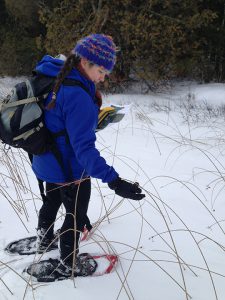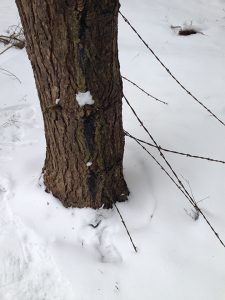
Did you know that nearly three-quarters of the lands we have protected are privately owned? In addition to the natural areas and preserves that you know and love, the Leelanau Conservancy has also protected over 8,400 acres of PRIVATE lands that are not open to public. Even though the general public can’t access them, these private farms and wetlands, forests and bogs provide an enormous benefit. They may preserve a view you cherish, wetlands that keep your lake pristine or provide habitat for the birds you enjoy seeing at your feeder.
Each year—now and forever–we must monitor all of the lands we have protected to ensure that their conservation values are intact and conservation easement agreements are being upheld. There are over 160 properties that Conservancy staff must walk each year and Yarrow Brown, Conservation Easement Program Manager, makes it all happen. With map and a “Trimble” Global Positioning Device in hand, she walks these properties in all seasons and in all weather.
On a March morning, I strapped on snowshoes and accompanied her on an annual monitoring visit to a private conservation easement on Bass Lake. Landowners are always alerted ahead of time about her visits, and afterward may receive a monitoring report if they desire. The day we visited Bass Lake, temps were in the mid-20s as we made our way along the frozen shore. Patches of blue parted grey skies and a single sand hill crane honked as it flew overhead. Across the lake, one house dominated the ridge. A few cottages tucked into the trees along the shore were barely visible.

As we walked to the end of the 87-acre parcel, Yarrow explained the role that annual monitoring plays in our stewardship program. “We look for violations of the easement, but not to play Big Brother,” she says. “Instead our role is to alert property owners to issues they might not be aware of.” It is also her job to make sure that when a property is sold or transferred to the next generation, everyone is aware of the terms of the conservation easement which helps to head off potential violations.
Some conservation easements are donated outright; in other cases we may purchase the development rights if there is a grant or other source of funding . In most cases, the landowners share our values, and this is the reason that they have collaborated on a conservation easement for their property is to ensure that its ecological values are protected in perpetuity.
The Bass Lake conservation easement is an ecological powerhouse. It includes 3,100 feet of undeveloped shoreline as well as 1,000 feet along the headwaters of Belanger Creek. Deer and bobcat tracks meander through the snow. Near shore, Yarrow, who has a M.S. degree in conservation biology points out dried, curled reeds poking through the ice. “Great fish habitat,” she comments. We enter a forest she deems “very healthy” that features mature yellow birch, hemlock and snags left standing–great habitat for owls and other animals. It’s an enchanting place.

Yarrow points out barbed wire—an old fence that has grown into a cedar tree. Beyond the forest is rolling farmland, also protected by the conservation easement. Without it, a number of homes might have grown up here instead of hay or cherry trees.
I think about this, and the value of our private protected lands as we turn and head back toward the car. Yarrow has seen nothing that concerns her aside from some snowmobile tracks at the north end that indicate trespass she will tell the landowner about. She shows me on the Trimble exactly where we’ve walked because the device tracks our movements. The squiggly lines embedded within the shaped parcel record her movements. In the course of the coming year, Yarrow and other staffers will log over 230 miles, checking property boundaries and making sure all is well at our natural areas and on private lands like Bass Lake. When we say we protect land forever, this is part of how we do it.—Carolyn Faught



